Applied Research Studies: Data Collection Methods and Biases Analysis
VerifiedAdded on 2023/01/13
|20
|8128
|98
Report
AI Summary
This report delves into the core concepts of applied research, focusing on data collection methods, particularly observation and questionnaires. The report begins by defining the key purpose of observation, outlining its advantages and disadvantages as a research approach. It explores the dimensions that differentiate various observation approaches, such as controlled, participant, structured, and concealed observation. The report further addresses the critical issue of observer bias, discussing strategies to minimize its impact on research outcomes. The report then transitions to online survey questionnaires, exploring their mechanisms, advantages, and disadvantages. The report emphasizes the principles of wording in questionnaire design, providing examples. It also examines the relationship between multiple data collection methods, the reliability and validity of measures, and critiques the assertion that multi-method approaches compound biases. The report provides a comprehensive analysis of the ethical considerations surrounding concealed observation and other research methodologies, ensuring a thorough understanding of the subject matter.
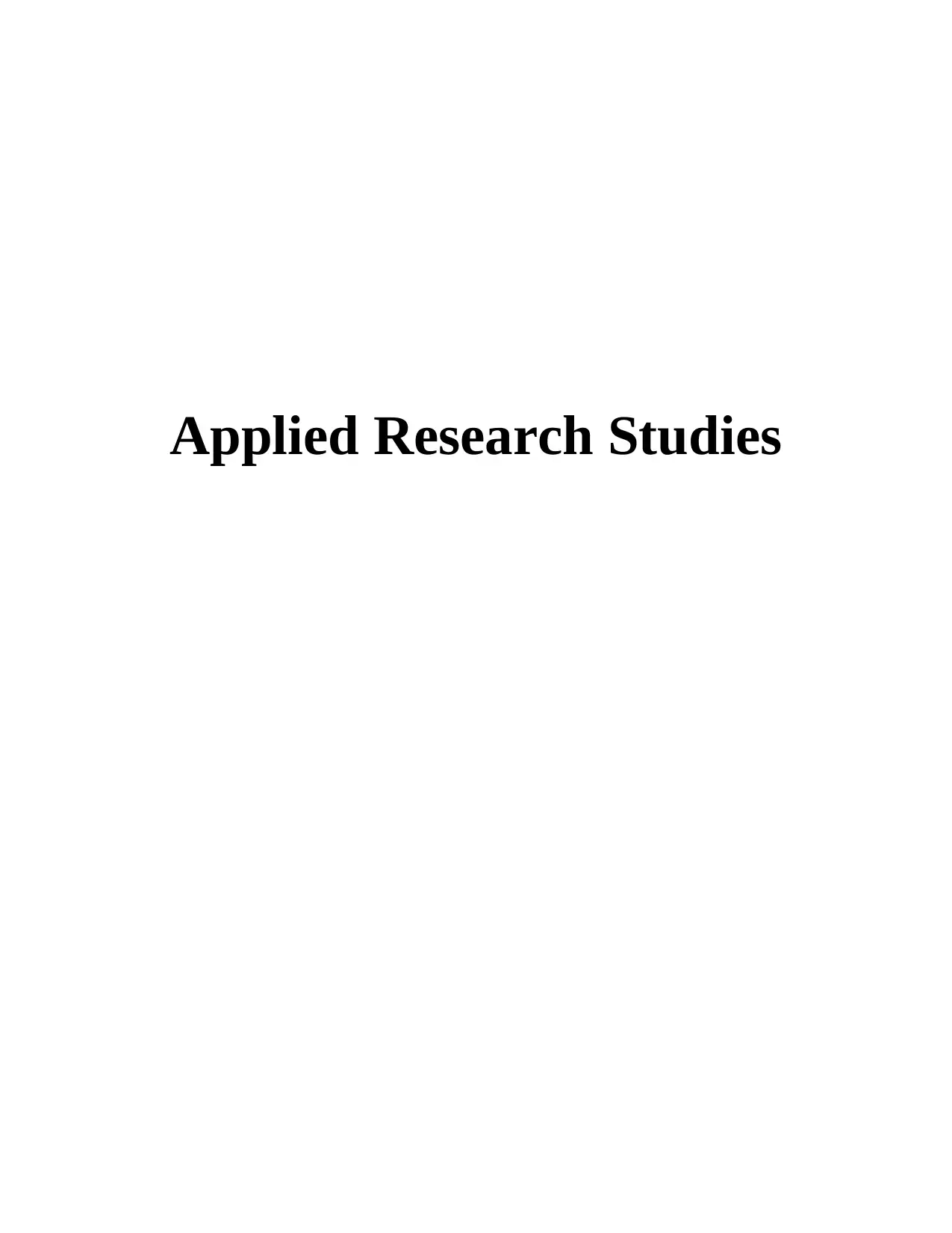
Applied Research Studies
Paraphrase This Document
Need a fresh take? Get an instant paraphrase of this document with our AI Paraphraser

Table of Contents
TASK 1............................................................................................................................................1
1. Describe the key purpose of observation, outlining advantages and disadvantages of this
research approach to collecting data.......................................................................................1
2. Discuss four dimensions that distinguish various approaches to observation....................3
3. A disadvantage of observation is observer bias. Discuss at least two ways of minimizing
observer bias...........................................................................................................................4
4. Provide a critical evaluation of the ethics of using concealed observation as a research
method....................................................................................................................................6
TASK 2............................................................................................................................................7
1. Advancement in technology have helped data gathering via online survey questionnaires?
Discuss the mechanism that can be used to administer online questionnaire and advantages
and disadvantages that may occur..........................................................................................7
2. Explain the principles of wording, stating how these are important in questionnaire design,
citing examples not in the book..............................................................................................9
3. How are multiple method of data collection and from multiple sources related to the
reliability and validity of measures?.....................................................................................10
4. “Every data collection method has its own built- in biases. Therefore, resorting to multi-
methods of data collection is only going to compound the biases.” Provide a critique of this
statement...............................................................................................................................12
REFERENCES..............................................................................................................................15
TASK 1............................................................................................................................................1
1. Describe the key purpose of observation, outlining advantages and disadvantages of this
research approach to collecting data.......................................................................................1
2. Discuss four dimensions that distinguish various approaches to observation....................3
3. A disadvantage of observation is observer bias. Discuss at least two ways of minimizing
observer bias...........................................................................................................................4
4. Provide a critical evaluation of the ethics of using concealed observation as a research
method....................................................................................................................................6
TASK 2............................................................................................................................................7
1. Advancement in technology have helped data gathering via online survey questionnaires?
Discuss the mechanism that can be used to administer online questionnaire and advantages
and disadvantages that may occur..........................................................................................7
2. Explain the principles of wording, stating how these are important in questionnaire design,
citing examples not in the book..............................................................................................9
3. How are multiple method of data collection and from multiple sources related to the
reliability and validity of measures?.....................................................................................10
4. “Every data collection method has its own built- in biases. Therefore, resorting to multi-
methods of data collection is only going to compound the biases.” Provide a critique of this
statement...............................................................................................................................12
REFERENCES..............................................................................................................................15
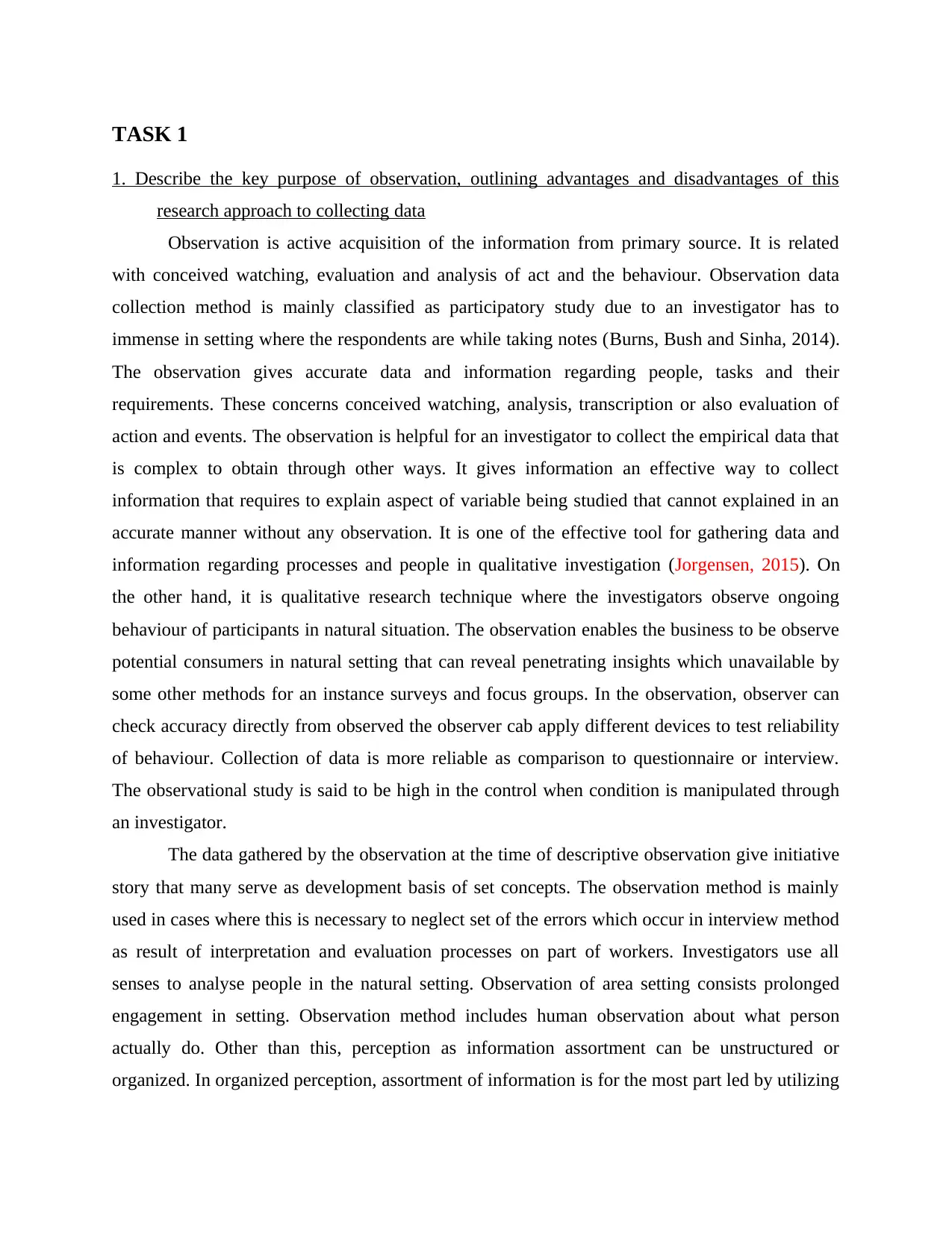
TASK 1
1. Describe the key purpose of observation, outlining advantages and disadvantages of this
research approach to collecting data
Observation is active acquisition of the information from primary source. It is related
with conceived watching, evaluation and analysis of act and the behaviour. Observation data
collection method is mainly classified as participatory study due to an investigator has to
immense in setting where the respondents are while taking notes (Burns, Bush and Sinha, 2014).
The observation gives accurate data and information regarding people, tasks and their
requirements. These concerns conceived watching, analysis, transcription or also evaluation of
action and events. The observation is helpful for an investigator to collect the empirical data that
is complex to obtain through other ways. It gives information an effective way to collect
information that requires to explain aspect of variable being studied that cannot explained in an
accurate manner without any observation. It is one of the effective tool for gathering data and
information regarding processes and people in qualitative investigation (Jorgensen, 2015). On
the other hand, it is qualitative research technique where the investigators observe ongoing
behaviour of participants in natural situation. The observation enables the business to be observe
potential consumers in natural setting that can reveal penetrating insights which unavailable by
some other methods for an instance surveys and focus groups. In the observation, observer can
check accuracy directly from observed the observer cab apply different devices to test reliability
of behaviour. Collection of data is more reliable as comparison to questionnaire or interview.
The observational study is said to be high in the control when condition is manipulated through
an investigator.
The data gathered by the observation at the time of descriptive observation give initiative
story that many serve as development basis of set concepts. The observation method is mainly
used in cases where this is necessary to neglect set of the errors which occur in interview method
as result of interpretation and evaluation processes on part of workers. Investigators use all
senses to analyse people in the natural setting. Observation of area setting consists prolonged
engagement in setting. Observation method includes human observation about what person
actually do. Other than this, perception as information assortment can be unstructured or
organized. In organized perception, assortment of information is for the most part led by utilizing
1. Describe the key purpose of observation, outlining advantages and disadvantages of this
research approach to collecting data
Observation is active acquisition of the information from primary source. It is related
with conceived watching, evaluation and analysis of act and the behaviour. Observation data
collection method is mainly classified as participatory study due to an investigator has to
immense in setting where the respondents are while taking notes (Burns, Bush and Sinha, 2014).
The observation gives accurate data and information regarding people, tasks and their
requirements. These concerns conceived watching, analysis, transcription or also evaluation of
action and events. The observation is helpful for an investigator to collect the empirical data that
is complex to obtain through other ways. It gives information an effective way to collect
information that requires to explain aspect of variable being studied that cannot explained in an
accurate manner without any observation. It is one of the effective tool for gathering data and
information regarding processes and people in qualitative investigation (Jorgensen, 2015). On
the other hand, it is qualitative research technique where the investigators observe ongoing
behaviour of participants in natural situation. The observation enables the business to be observe
potential consumers in natural setting that can reveal penetrating insights which unavailable by
some other methods for an instance surveys and focus groups. In the observation, observer can
check accuracy directly from observed the observer cab apply different devices to test reliability
of behaviour. Collection of data is more reliable as comparison to questionnaire or interview.
The observational study is said to be high in the control when condition is manipulated through
an investigator.
The data gathered by the observation at the time of descriptive observation give initiative
story that many serve as development basis of set concepts. The observation method is mainly
used in cases where this is necessary to neglect set of the errors which occur in interview method
as result of interpretation and evaluation processes on part of workers. Investigators use all
senses to analyse people in the natural setting. Observation of area setting consists prolonged
engagement in setting. Observation method includes human observation about what person
actually do. Other than this, perception as information assortment can be unstructured or
organized. In organized perception, assortment of information is for the most part led by utilizing
⊘ This is a preview!⊘
Do you want full access?
Subscribe today to unlock all pages.

Trusted by 1+ million students worldwide
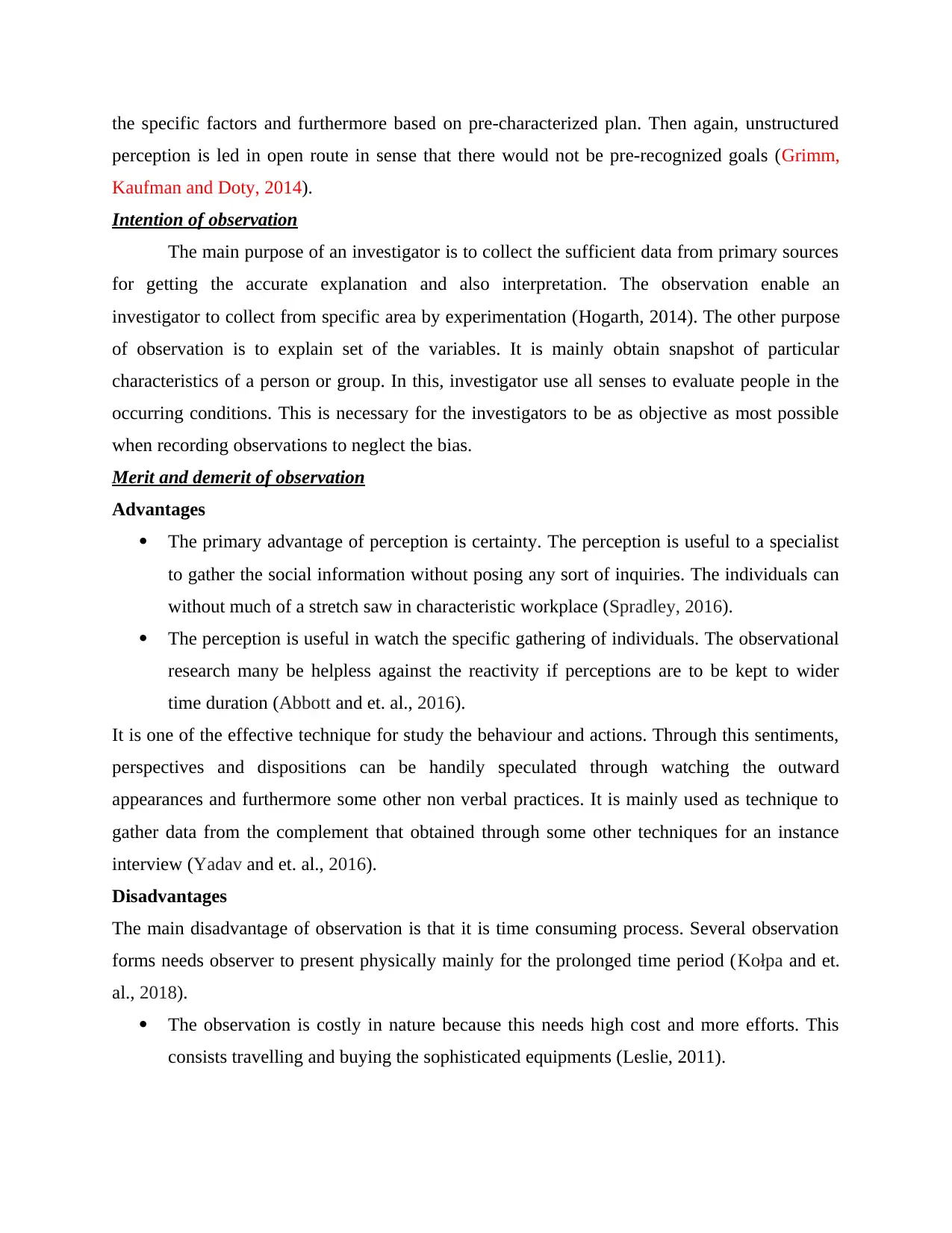
the specific factors and furthermore based on pre-characterized plan. Then again, unstructured
perception is led in open route in sense that there would not be pre-recognized goals (Grimm,
Kaufman and Doty, 2014).
Intention of observation
The main purpose of an investigator is to collect the sufficient data from primary sources
for getting the accurate explanation and also interpretation. The observation enable an
investigator to collect from specific area by experimentation (Hogarth, 2014). The other purpose
of observation is to explain set of the variables. It is mainly obtain snapshot of particular
characteristics of a person or group. In this, investigator use all senses to evaluate people in the
occurring conditions. This is necessary for the investigators to be as objective as most possible
when recording observations to neglect the bias.
Merit and demerit of observation
Advantages
The primary advantage of perception is certainty. The perception is useful to a specialist
to gather the social information without posing any sort of inquiries. The individuals can
without much of a stretch saw in characteristic workplace (Spradley, 2016).
The perception is useful in watch the specific gathering of individuals. The observational
research many be helpless against the reactivity if perceptions are to be kept to wider
time duration (Abbott and et. al., 2016).
It is one of the effective technique for study the behaviour and actions. Through this sentiments,
perspectives and dispositions can be handily speculated through watching the outward
appearances and furthermore some other non verbal practices. It is mainly used as technique to
gather data from the complement that obtained through some other techniques for an instance
interview (Yadav and et. al., 2016).
Disadvantages
The main disadvantage of observation is that it is time consuming process. Several observation
forms needs observer to present physically mainly for the prolonged time period (Kołpa and et.
al., 2018).
The observation is costly in nature because this needs high cost and more efforts. This
consists travelling and buying the sophisticated equipments (Leslie, 2011).
perception is led in open route in sense that there would not be pre-recognized goals (Grimm,
Kaufman and Doty, 2014).
Intention of observation
The main purpose of an investigator is to collect the sufficient data from primary sources
for getting the accurate explanation and also interpretation. The observation enable an
investigator to collect from specific area by experimentation (Hogarth, 2014). The other purpose
of observation is to explain set of the variables. It is mainly obtain snapshot of particular
characteristics of a person or group. In this, investigator use all senses to evaluate people in the
occurring conditions. This is necessary for the investigators to be as objective as most possible
when recording observations to neglect the bias.
Merit and demerit of observation
Advantages
The primary advantage of perception is certainty. The perception is useful to a specialist
to gather the social information without posing any sort of inquiries. The individuals can
without much of a stretch saw in characteristic workplace (Spradley, 2016).
The perception is useful in watch the specific gathering of individuals. The observational
research many be helpless against the reactivity if perceptions are to be kept to wider
time duration (Abbott and et. al., 2016).
It is one of the effective technique for study the behaviour and actions. Through this sentiments,
perspectives and dispositions can be handily speculated through watching the outward
appearances and furthermore some other non verbal practices. It is mainly used as technique to
gather data from the complement that obtained through some other techniques for an instance
interview (Yadav and et. al., 2016).
Disadvantages
The main disadvantage of observation is that it is time consuming process. Several observation
forms needs observer to present physically mainly for the prolonged time period (Kołpa and et.
al., 2018).
The observation is costly in nature because this needs high cost and more efforts. This
consists travelling and buying the sophisticated equipments (Leslie, 2011).
Paraphrase This Document
Need a fresh take? Get an instant paraphrase of this document with our AI Paraphraser
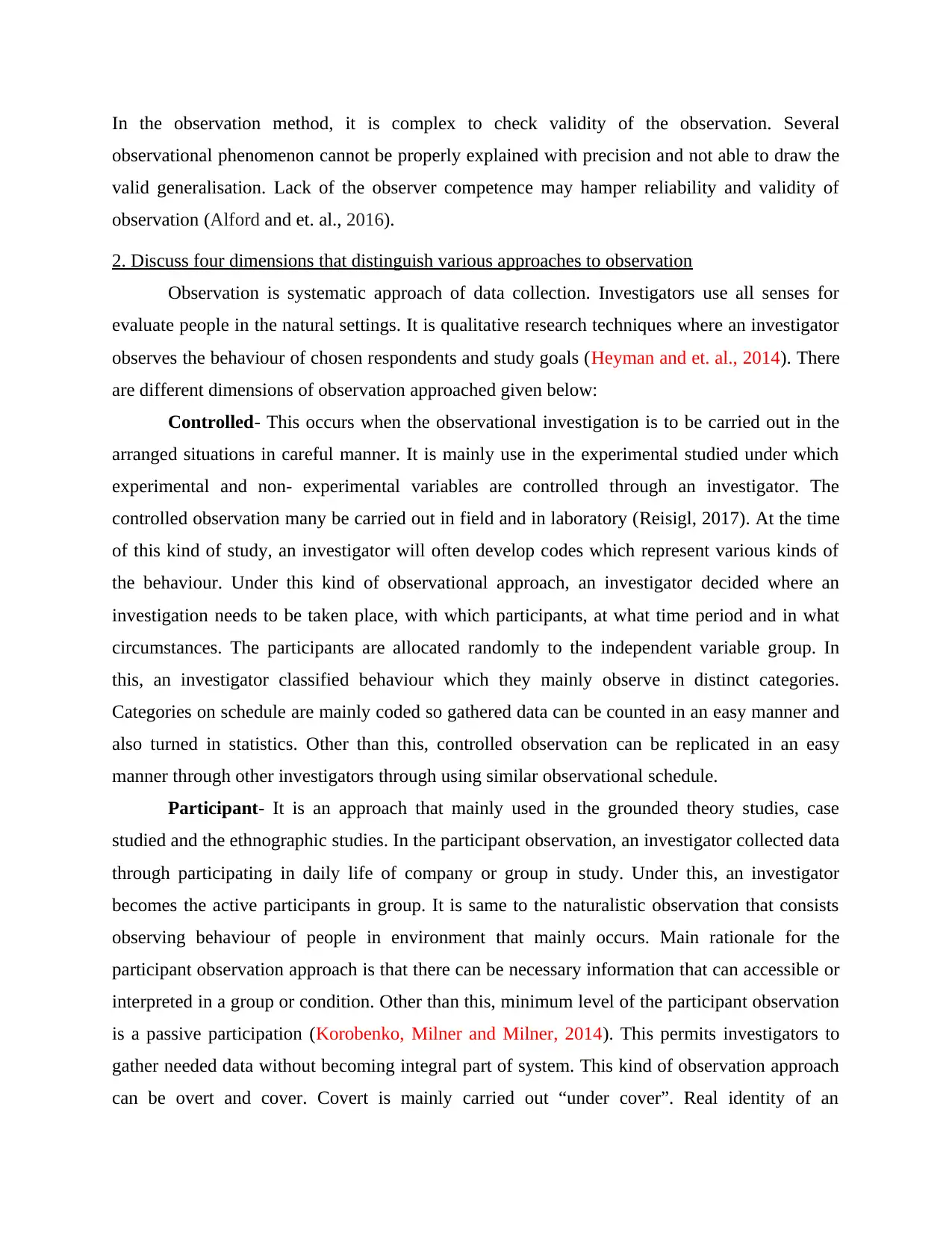
In the observation method, it is complex to check validity of the observation. Several
observational phenomenon cannot be properly explained with precision and not able to draw the
valid generalisation. Lack of the observer competence may hamper reliability and validity of
observation (Alford and et. al., 2016).
2. Discuss four dimensions that distinguish various approaches to observation
Observation is systematic approach of data collection. Investigators use all senses for
evaluate people in the natural settings. It is qualitative research techniques where an investigator
observes the behaviour of chosen respondents and study goals (Heyman and et. al., 2014). There
are different dimensions of observation approached given below:
Controlled- This occurs when the observational investigation is to be carried out in the
arranged situations in careful manner. It is mainly use in the experimental studied under which
experimental and non- experimental variables are controlled through an investigator. The
controlled observation many be carried out in field and in laboratory (Reisigl, 2017). At the time
of this kind of study, an investigator will often develop codes which represent various kinds of
the behaviour. Under this kind of observational approach, an investigator decided where an
investigation needs to be taken place, with which participants, at what time period and in what
circumstances. The participants are allocated randomly to the independent variable group. In
this, an investigator classified behaviour which they mainly observe in distinct categories.
Categories on schedule are mainly coded so gathered data can be counted in an easy manner and
also turned in statistics. Other than this, controlled observation can be replicated in an easy
manner through other investigators through using similar observational schedule.
Participant- It is an approach that mainly used in the grounded theory studies, case
studied and the ethnographic studies. In the participant observation, an investigator collected data
through participating in daily life of company or group in study. Under this, an investigator
becomes the active participants in group. It is same to the naturalistic observation that consists
observing behaviour of people in environment that mainly occurs. Main rationale for the
participant observation approach is that there can be necessary information that can accessible or
interpreted in a group or condition. Other than this, minimum level of the participant observation
is a passive participation (Korobenko, Milner and Milner, 2014). This permits investigators to
gather needed data without becoming integral part of system. This kind of observation approach
can be overt and cover. Covert is mainly carried out “under cover”. Real identity of an
observational phenomenon cannot be properly explained with precision and not able to draw the
valid generalisation. Lack of the observer competence may hamper reliability and validity of
observation (Alford and et. al., 2016).
2. Discuss four dimensions that distinguish various approaches to observation
Observation is systematic approach of data collection. Investigators use all senses for
evaluate people in the natural settings. It is qualitative research techniques where an investigator
observes the behaviour of chosen respondents and study goals (Heyman and et. al., 2014). There
are different dimensions of observation approached given below:
Controlled- This occurs when the observational investigation is to be carried out in the
arranged situations in careful manner. It is mainly use in the experimental studied under which
experimental and non- experimental variables are controlled through an investigator. The
controlled observation many be carried out in field and in laboratory (Reisigl, 2017). At the time
of this kind of study, an investigator will often develop codes which represent various kinds of
the behaviour. Under this kind of observational approach, an investigator decided where an
investigation needs to be taken place, with which participants, at what time period and in what
circumstances. The participants are allocated randomly to the independent variable group. In
this, an investigator classified behaviour which they mainly observe in distinct categories.
Categories on schedule are mainly coded so gathered data can be counted in an easy manner and
also turned in statistics. Other than this, controlled observation can be replicated in an easy
manner through other investigators through using similar observational schedule.
Participant- It is an approach that mainly used in the grounded theory studies, case
studied and the ethnographic studies. In the participant observation, an investigator collected data
through participating in daily life of company or group in study. Under this, an investigator
becomes the active participants in group. It is same to the naturalistic observation that consists
observing behaviour of people in environment that mainly occurs. Main rationale for the
participant observation approach is that there can be necessary information that can accessible or
interpreted in a group or condition. Other than this, minimum level of the participant observation
is a passive participation (Korobenko, Milner and Milner, 2014). This permits investigators to
gather needed data without becoming integral part of system. This kind of observation approach
can be overt and cover. Covert is mainly carried out “under cover”. Real identity of an
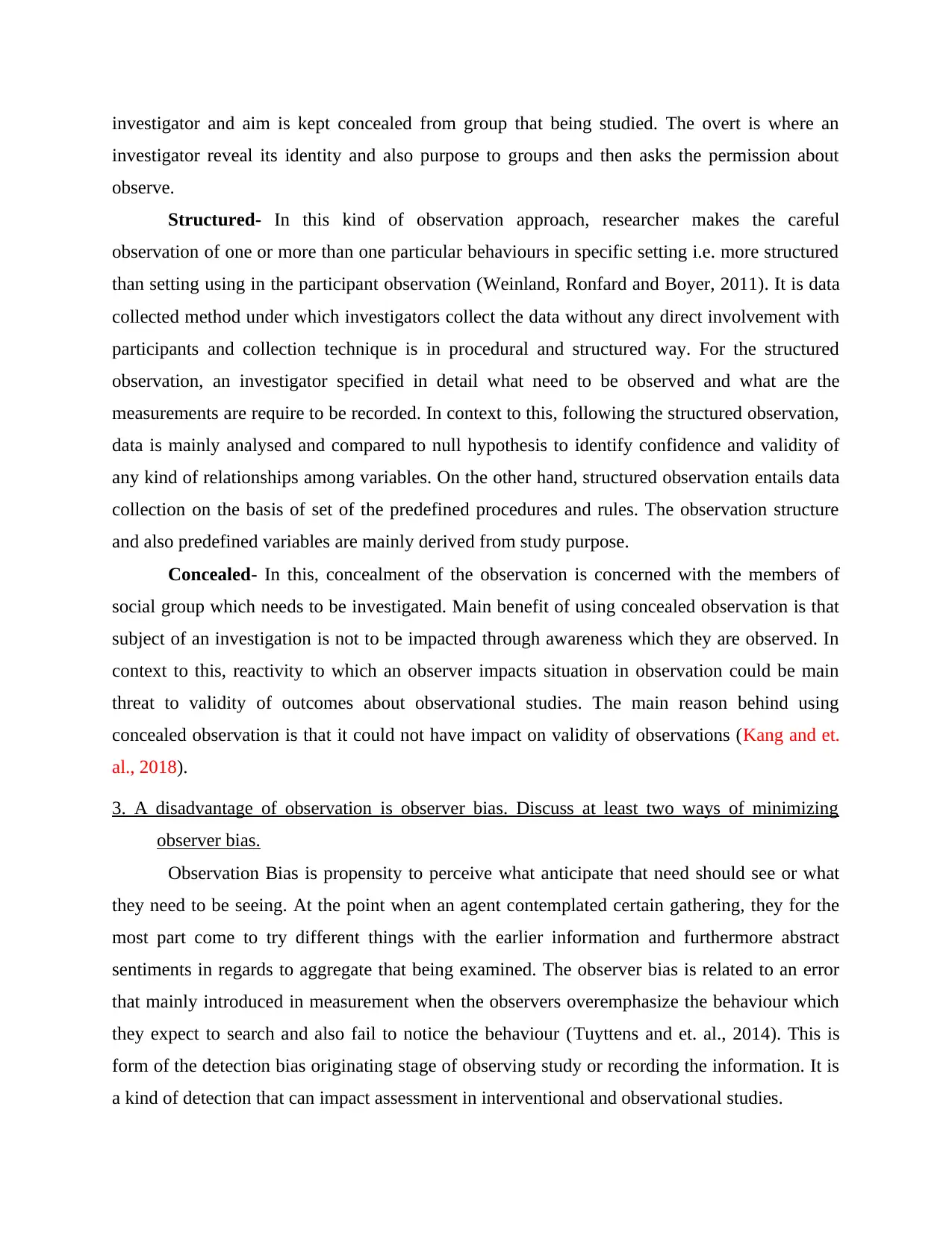
investigator and aim is kept concealed from group that being studied. The overt is where an
investigator reveal its identity and also purpose to groups and then asks the permission about
observe.
Structured- In this kind of observation approach, researcher makes the careful
observation of one or more than one particular behaviours in specific setting i.e. more structured
than setting using in the participant observation (Weinland, Ronfard and Boyer, 2011). It is data
collected method under which investigators collect the data without any direct involvement with
participants and collection technique is in procedural and structured way. For the structured
observation, an investigator specified in detail what need to be observed and what are the
measurements are require to be recorded. In context to this, following the structured observation,
data is mainly analysed and compared to null hypothesis to identify confidence and validity of
any kind of relationships among variables. On the other hand, structured observation entails data
collection on the basis of set of the predefined procedures and rules. The observation structure
and also predefined variables are mainly derived from study purpose.
Concealed- In this, concealment of the observation is concerned with the members of
social group which needs to be investigated. Main benefit of using concealed observation is that
subject of an investigation is not to be impacted through awareness which they are observed. In
context to this, reactivity to which an observer impacts situation in observation could be main
threat to validity of outcomes about observational studies. The main reason behind using
concealed observation is that it could not have impact on validity of observations (Kang and et.
al., 2018).
3. A disadvantage of observation is observer bias. Discuss at least two ways of minimizing
observer bias.
Observation Bias is propensity to perceive what anticipate that need should see or what
they need to be seeing. At the point when an agent contemplated certain gathering, they for the
most part come to try different things with the earlier information and furthermore abstract
sentiments in regards to aggregate that being examined. The observer bias is related to an error
that mainly introduced in measurement when the observers overemphasize the behaviour which
they expect to search and also fail to notice the behaviour (Tuyttens and et. al., 2014). This is
form of the detection bias originating stage of observing study or recording the information. It is
a kind of detection that can impact assessment in interventional and observational studies.
investigator reveal its identity and also purpose to groups and then asks the permission about
observe.
Structured- In this kind of observation approach, researcher makes the careful
observation of one or more than one particular behaviours in specific setting i.e. more structured
than setting using in the participant observation (Weinland, Ronfard and Boyer, 2011). It is data
collected method under which investigators collect the data without any direct involvement with
participants and collection technique is in procedural and structured way. For the structured
observation, an investigator specified in detail what need to be observed and what are the
measurements are require to be recorded. In context to this, following the structured observation,
data is mainly analysed and compared to null hypothesis to identify confidence and validity of
any kind of relationships among variables. On the other hand, structured observation entails data
collection on the basis of set of the predefined procedures and rules. The observation structure
and also predefined variables are mainly derived from study purpose.
Concealed- In this, concealment of the observation is concerned with the members of
social group which needs to be investigated. Main benefit of using concealed observation is that
subject of an investigation is not to be impacted through awareness which they are observed. In
context to this, reactivity to which an observer impacts situation in observation could be main
threat to validity of outcomes about observational studies. The main reason behind using
concealed observation is that it could not have impact on validity of observations (Kang and et.
al., 2018).
3. A disadvantage of observation is observer bias. Discuss at least two ways of minimizing
observer bias.
Observation Bias is propensity to perceive what anticipate that need should see or what
they need to be seeing. At the point when an agent contemplated certain gathering, they for the
most part come to try different things with the earlier information and furthermore abstract
sentiments in regards to aggregate that being examined. The observer bias is related to an error
that mainly introduced in measurement when the observers overemphasize the behaviour which
they expect to search and also fail to notice the behaviour (Tuyttens and et. al., 2014). This is
form of the detection bias originating stage of observing study or recording the information. It is
a kind of detection that can impact assessment in interventional and observational studies.
⊘ This is a preview!⊘
Do you want full access?
Subscribe today to unlock all pages.

Trusted by 1+ million students worldwide
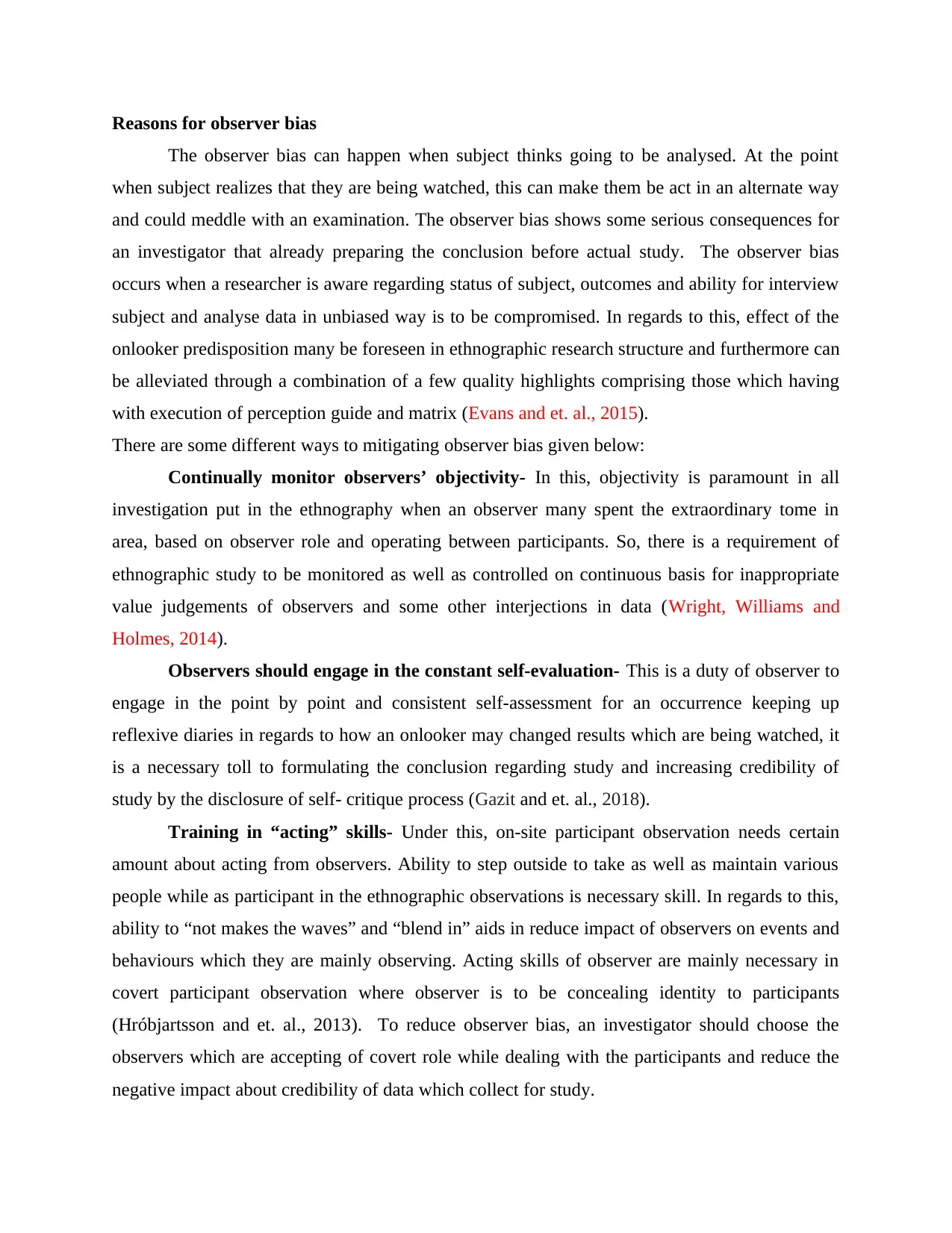
Reasons for observer bias
The observer bias can happen when subject thinks going to be analysed. At the point
when subject realizes that they are being watched, this can make them be act in an alternate way
and could meddle with an examination. The observer bias shows some serious consequences for
an investigator that already preparing the conclusion before actual study. The observer bias
occurs when a researcher is aware regarding status of subject, outcomes and ability for interview
subject and analyse data in unbiased way is to be compromised. In regards to this, effect of the
onlooker predisposition many be foreseen in ethnographic research structure and furthermore can
be alleviated through a combination of a few quality highlights comprising those which having
with execution of perception guide and matrix (Evans and et. al., 2015).
There are some different ways to mitigating observer bias given below:
Continually monitor observers’ objectivity- In this, objectivity is paramount in all
investigation put in the ethnography when an observer many spent the extraordinary tome in
area, based on observer role and operating between participants. So, there is a requirement of
ethnographic study to be monitored as well as controlled on continuous basis for inappropriate
value judgements of observers and some other interjections in data (Wright, Williams and
Holmes, 2014).
Observers should engage in the constant self-evaluation- This is a duty of observer to
engage in the point by point and consistent self-assessment for an occurrence keeping up
reflexive diaries in regards to how an onlooker may changed results which are being watched, it
is a necessary toll to formulating the conclusion regarding study and increasing credibility of
study by the disclosure of self- critique process (Gazit and et. al., 2018).
Training in “acting” skills- Under this, on-site participant observation needs certain
amount about acting from observers. Ability to step outside to take as well as maintain various
people while as participant in the ethnographic observations is necessary skill. In regards to this,
ability to “not makes the waves” and “blend in” aids in reduce impact of observers on events and
behaviours which they are mainly observing. Acting skills of observer are mainly necessary in
covert participant observation where observer is to be concealing identity to participants
(Hróbjartsson and et. al., 2013). To reduce observer bias, an investigator should choose the
observers which are accepting of covert role while dealing with the participants and reduce the
negative impact about credibility of data which collect for study.
The observer bias can happen when subject thinks going to be analysed. At the point
when subject realizes that they are being watched, this can make them be act in an alternate way
and could meddle with an examination. The observer bias shows some serious consequences for
an investigator that already preparing the conclusion before actual study. The observer bias
occurs when a researcher is aware regarding status of subject, outcomes and ability for interview
subject and analyse data in unbiased way is to be compromised. In regards to this, effect of the
onlooker predisposition many be foreseen in ethnographic research structure and furthermore can
be alleviated through a combination of a few quality highlights comprising those which having
with execution of perception guide and matrix (Evans and et. al., 2015).
There are some different ways to mitigating observer bias given below:
Continually monitor observers’ objectivity- In this, objectivity is paramount in all
investigation put in the ethnography when an observer many spent the extraordinary tome in
area, based on observer role and operating between participants. So, there is a requirement of
ethnographic study to be monitored as well as controlled on continuous basis for inappropriate
value judgements of observers and some other interjections in data (Wright, Williams and
Holmes, 2014).
Observers should engage in the constant self-evaluation- This is a duty of observer to
engage in the point by point and consistent self-assessment for an occurrence keeping up
reflexive diaries in regards to how an onlooker may changed results which are being watched, it
is a necessary toll to formulating the conclusion regarding study and increasing credibility of
study by the disclosure of self- critique process (Gazit and et. al., 2018).
Training in “acting” skills- Under this, on-site participant observation needs certain
amount about acting from observers. Ability to step outside to take as well as maintain various
people while as participant in the ethnographic observations is necessary skill. In regards to this,
ability to “not makes the waves” and “blend in” aids in reduce impact of observers on events and
behaviours which they are mainly observing. Acting skills of observer are mainly necessary in
covert participant observation where observer is to be concealing identity to participants
(Hróbjartsson and et. al., 2013). To reduce observer bias, an investigator should choose the
observers which are accepting of covert role while dealing with the participants and reduce the
negative impact about credibility of data which collect for study.
Paraphrase This Document
Need a fresh take? Get an instant paraphrase of this document with our AI Paraphraser
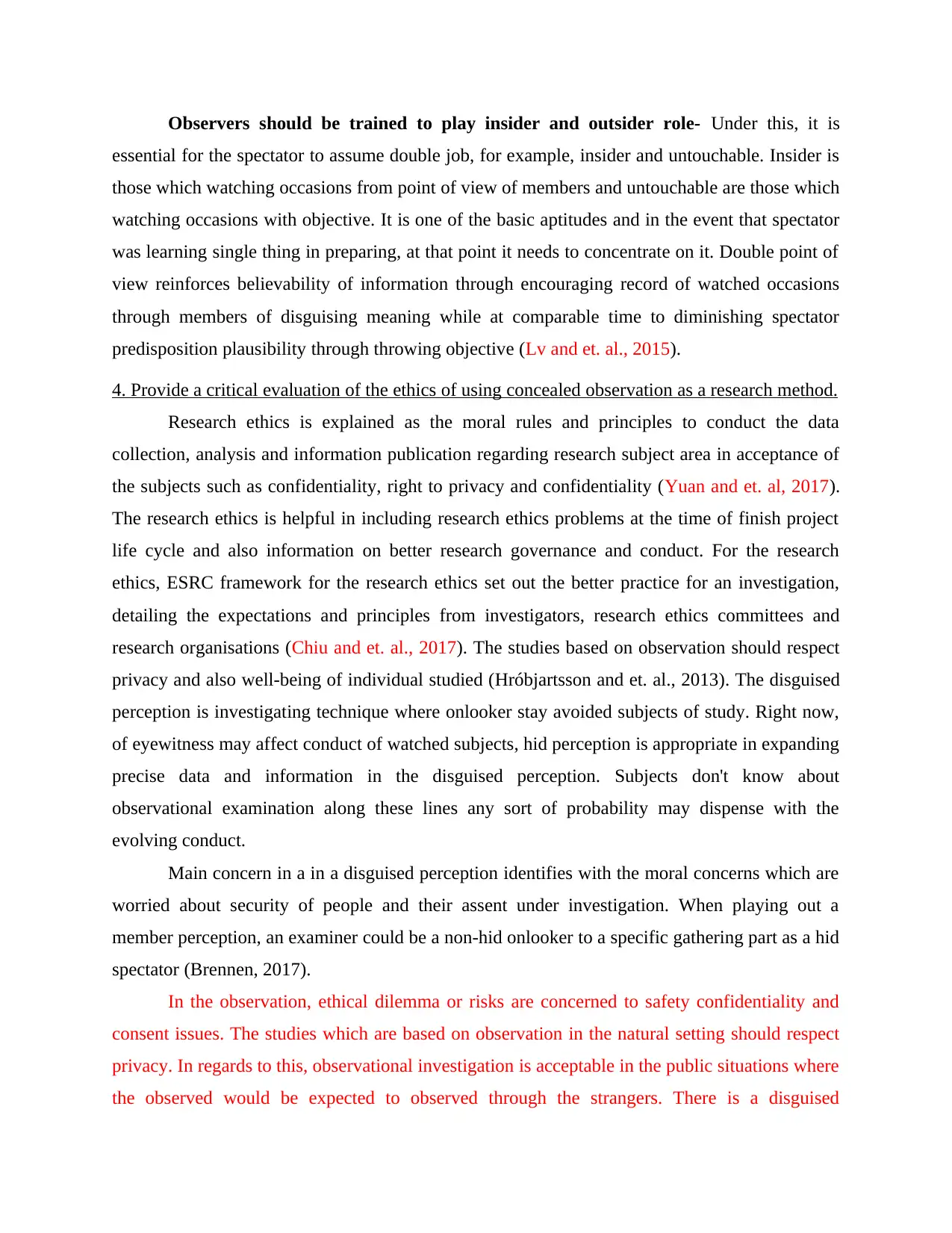
Observers should be trained to play insider and outsider role- Under this, it is
essential for the spectator to assume double job, for example, insider and untouchable. Insider is
those which watching occasions from point of view of members and untouchable are those which
watching occasions with objective. It is one of the basic aptitudes and in the event that spectator
was learning single thing in preparing, at that point it needs to concentrate on it. Double point of
view reinforces believability of information through encouraging record of watched occasions
through members of disguising meaning while at comparable time to diminishing spectator
predisposition plausibility through throwing objective (Lv and et. al., 2015).
4. Provide a critical evaluation of the ethics of using concealed observation as a research method.
Research ethics is explained as the moral rules and principles to conduct the data
collection, analysis and information publication regarding research subject area in acceptance of
the subjects such as confidentiality, right to privacy and confidentiality (Yuan and et. al, 2017).
The research ethics is helpful in including research ethics problems at the time of finish project
life cycle and also information on better research governance and conduct. For the research
ethics, ESRC framework for the research ethics set out the better practice for an investigation,
detailing the expectations and principles from investigators, research ethics committees and
research organisations (Chiu and et. al., 2017). The studies based on observation should respect
privacy and also well-being of individual studied (Hróbjartsson and et. al., 2013). The disguised
perception is investigating technique where onlooker stay avoided subjects of study. Right now,
of eyewitness may affect conduct of watched subjects, hid perception is appropriate in expanding
precise data and information in the disguised perception. Subjects don't know about
observational examination along these lines any sort of probability may dispense with the
evolving conduct.
Main concern in a in a disguised perception identifies with the moral concerns which are
worried about security of people and their assent under investigation. When playing out a
member perception, an examiner could be a non-hid onlooker to a specific gathering part as a hid
spectator (Brennen, 2017).
In the observation, ethical dilemma or risks are concerned to safety confidentiality and
consent issues. The studies which are based on observation in the natural setting should respect
privacy. In regards to this, observational investigation is acceptable in the public situations where
the observed would be expected to observed through the strangers. There is a disguised
essential for the spectator to assume double job, for example, insider and untouchable. Insider is
those which watching occasions from point of view of members and untouchable are those which
watching occasions with objective. It is one of the basic aptitudes and in the event that spectator
was learning single thing in preparing, at that point it needs to concentrate on it. Double point of
view reinforces believability of information through encouraging record of watched occasions
through members of disguising meaning while at comparable time to diminishing spectator
predisposition plausibility through throwing objective (Lv and et. al., 2015).
4. Provide a critical evaluation of the ethics of using concealed observation as a research method.
Research ethics is explained as the moral rules and principles to conduct the data
collection, analysis and information publication regarding research subject area in acceptance of
the subjects such as confidentiality, right to privacy and confidentiality (Yuan and et. al, 2017).
The research ethics is helpful in including research ethics problems at the time of finish project
life cycle and also information on better research governance and conduct. For the research
ethics, ESRC framework for the research ethics set out the better practice for an investigation,
detailing the expectations and principles from investigators, research ethics committees and
research organisations (Chiu and et. al., 2017). The studies based on observation should respect
privacy and also well-being of individual studied (Hróbjartsson and et. al., 2013). The disguised
perception is investigating technique where onlooker stay avoided subjects of study. Right now,
of eyewitness may affect conduct of watched subjects, hid perception is appropriate in expanding
precise data and information in the disguised perception. Subjects don't know about
observational examination along these lines any sort of probability may dispense with the
evolving conduct.
Main concern in a in a disguised perception identifies with the moral concerns which are
worried about security of people and their assent under investigation. When playing out a
member perception, an examiner could be a non-hid onlooker to a specific gathering part as a hid
spectator (Brennen, 2017).
In the observation, ethical dilemma or risks are concerned to safety confidentiality and
consent issues. The studies which are based on observation in the natural setting should respect
privacy. In regards to this, observational investigation is acceptable in the public situations where
the observed would be expected to observed through the strangers. There is a disguised
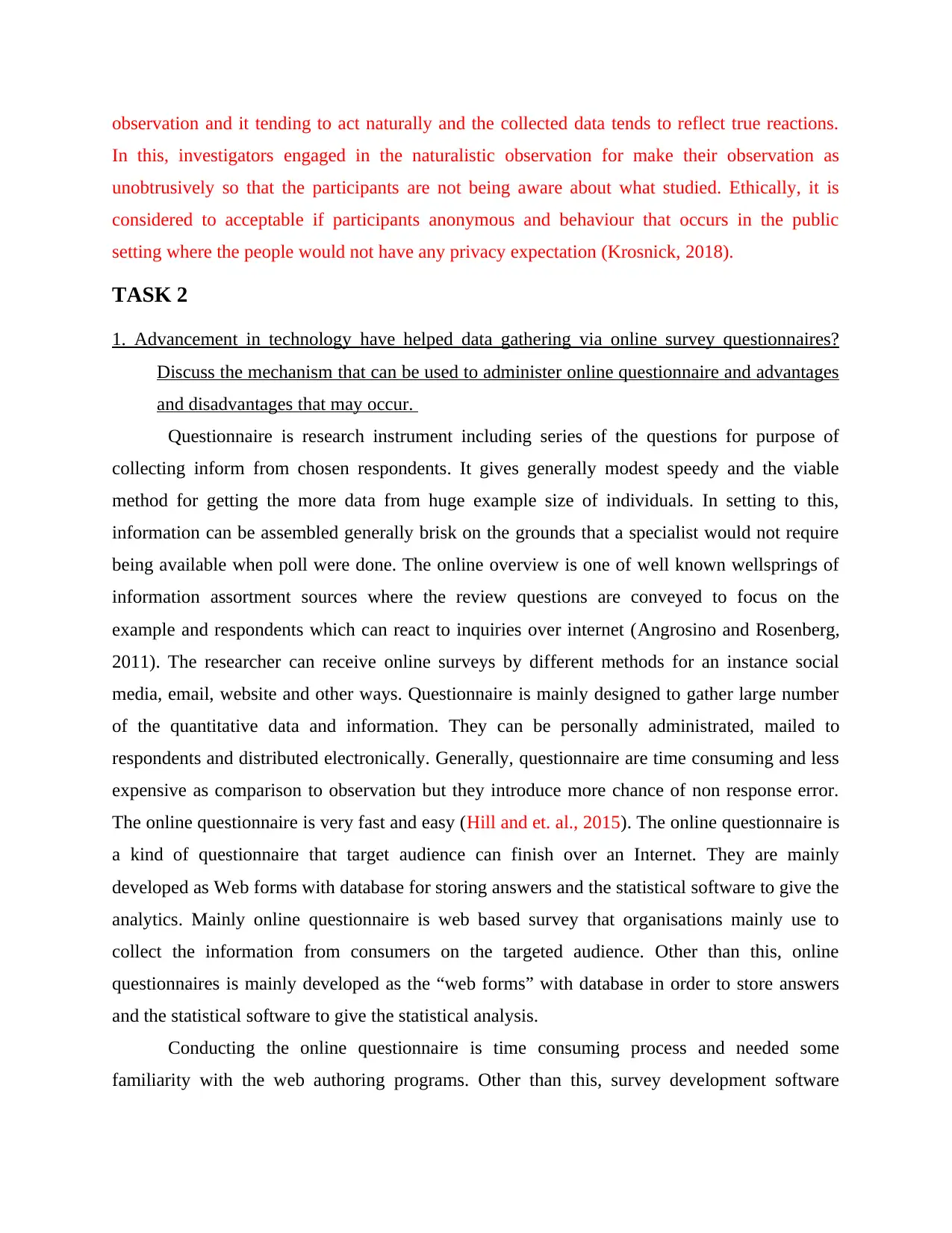
observation and it tending to act naturally and the collected data tends to reflect true reactions.
In this, investigators engaged in the naturalistic observation for make their observation as
unobtrusively so that the participants are not being aware about what studied. Ethically, it is
considered to acceptable if participants anonymous and behaviour that occurs in the public
setting where the people would not have any privacy expectation (Krosnick, 2018).
TASK 2
1. Advancement in technology have helped data gathering via online survey questionnaires?
Discuss the mechanism that can be used to administer online questionnaire and advantages
and disadvantages that may occur.
Questionnaire is research instrument including series of the questions for purpose of
collecting inform from chosen respondents. It gives generally modest speedy and the viable
method for getting the more data from huge example size of individuals. In setting to this,
information can be assembled generally brisk on the grounds that a specialist would not require
being available when poll were done. The online overview is one of well known wellsprings of
information assortment sources where the review questions are conveyed to focus on the
example and respondents which can react to inquiries over internet (Angrosino and Rosenberg,
2011). The researcher can receive online surveys by different methods for an instance social
media, email, website and other ways. Questionnaire is mainly designed to gather large number
of the quantitative data and information. They can be personally administrated, mailed to
respondents and distributed electronically. Generally, questionnaire are time consuming and less
expensive as comparison to observation but they introduce more chance of non response error.
The online questionnaire is very fast and easy (Hill and et. al., 2015). The online questionnaire is
a kind of questionnaire that target audience can finish over an Internet. They are mainly
developed as Web forms with database for storing answers and the statistical software to give the
analytics. Mainly online questionnaire is web based survey that organisations mainly use to
collect the information from consumers on the targeted audience. Other than this, online
questionnaires is mainly developed as the “web forms” with database in order to store answers
and the statistical software to give the statistical analysis.
Conducting the online questionnaire is time consuming process and needed some
familiarity with the web authoring programs. Other than this, survey development software
In this, investigators engaged in the naturalistic observation for make their observation as
unobtrusively so that the participants are not being aware about what studied. Ethically, it is
considered to acceptable if participants anonymous and behaviour that occurs in the public
setting where the people would not have any privacy expectation (Krosnick, 2018).
TASK 2
1. Advancement in technology have helped data gathering via online survey questionnaires?
Discuss the mechanism that can be used to administer online questionnaire and advantages
and disadvantages that may occur.
Questionnaire is research instrument including series of the questions for purpose of
collecting inform from chosen respondents. It gives generally modest speedy and the viable
method for getting the more data from huge example size of individuals. In setting to this,
information can be assembled generally brisk on the grounds that a specialist would not require
being available when poll were done. The online overview is one of well known wellsprings of
information assortment sources where the review questions are conveyed to focus on the
example and respondents which can react to inquiries over internet (Angrosino and Rosenberg,
2011). The researcher can receive online surveys by different methods for an instance social
media, email, website and other ways. Questionnaire is mainly designed to gather large number
of the quantitative data and information. They can be personally administrated, mailed to
respondents and distributed electronically. Generally, questionnaire are time consuming and less
expensive as comparison to observation but they introduce more chance of non response error.
The online questionnaire is very fast and easy (Hill and et. al., 2015). The online questionnaire is
a kind of questionnaire that target audience can finish over an Internet. They are mainly
developed as Web forms with database for storing answers and the statistical software to give the
analytics. Mainly online questionnaire is web based survey that organisations mainly use to
collect the information from consumers on the targeted audience. Other than this, online
questionnaires is mainly developed as the “web forms” with database in order to store answers
and the statistical software to give the statistical analysis.
Conducting the online questionnaire is time consuming process and needed some
familiarity with the web authoring programs. Other than this, survey development software
⊘ This is a preview!⊘
Do you want full access?
Subscribe today to unlock all pages.

Trusted by 1+ million students worldwide
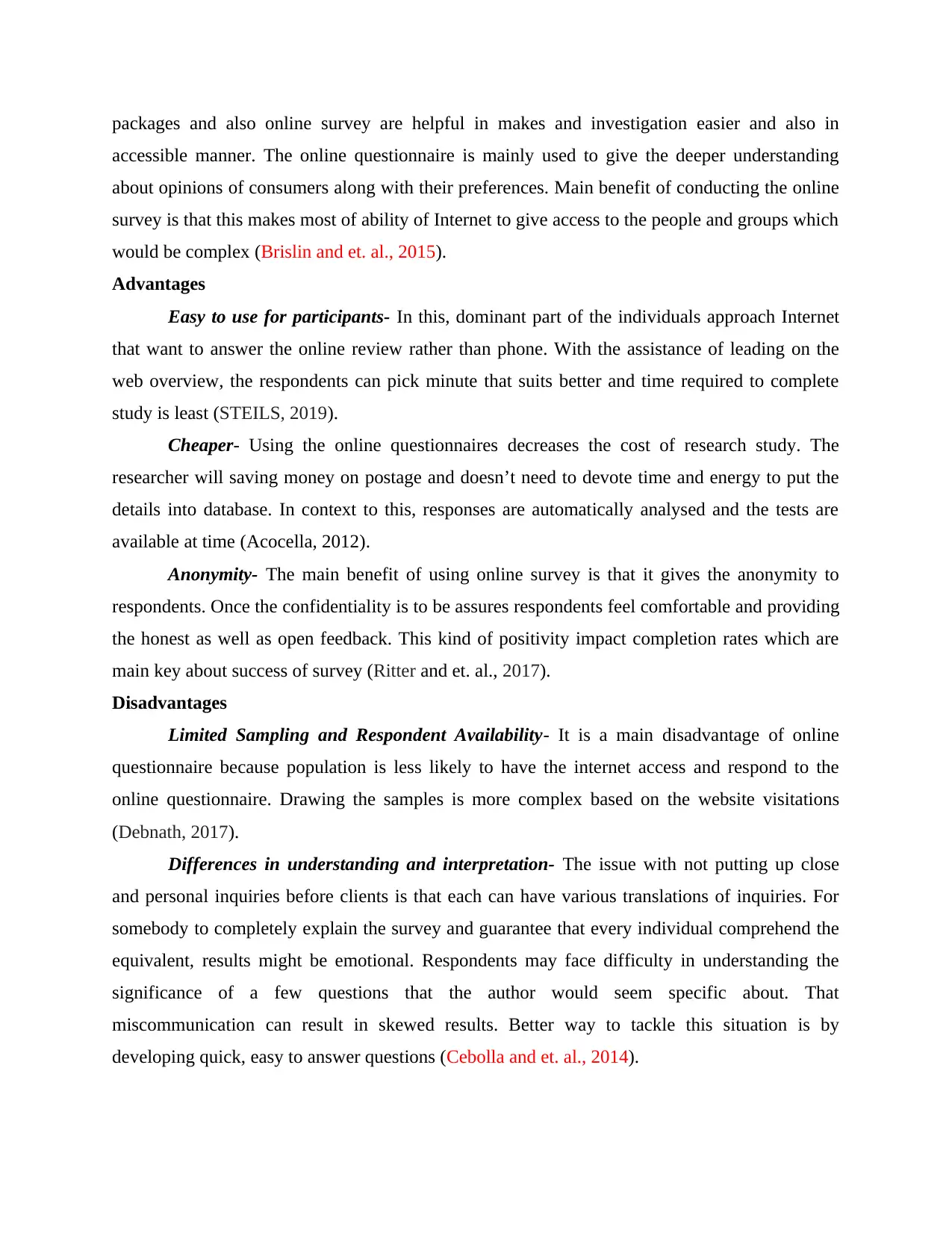
packages and also online survey are helpful in makes and investigation easier and also in
accessible manner. The online questionnaire is mainly used to give the deeper understanding
about opinions of consumers along with their preferences. Main benefit of conducting the online
survey is that this makes most of ability of Internet to give access to the people and groups which
would be complex (Brislin and et. al., 2015).
Advantages
Easy to use for participants- In this, dominant part of the individuals approach Internet
that want to answer the online review rather than phone. With the assistance of leading on the
web overview, the respondents can pick minute that suits better and time required to complete
study is least (STEILS, 2019).
Cheaper- Using the online questionnaires decreases the cost of research study. The
researcher will saving money on postage and doesn’t need to devote time and energy to put the
details into database. In context to this, responses are automatically analysed and the tests are
available at time (Acocella, 2012).
Anonymity- The main benefit of using online survey is that it gives the anonymity to
respondents. Once the confidentiality is to be assures respondents feel comfortable and providing
the honest as well as open feedback. This kind of positivity impact completion rates which are
main key about success of survey (Ritter and et. al., 2017).
Disadvantages
Limited Sampling and Respondent Availability- It is a main disadvantage of online
questionnaire because population is less likely to have the internet access and respond to the
online questionnaire. Drawing the samples is more complex based on the website visitations
(Debnath, 2017).
Differences in understanding and interpretation- The issue with not putting up close
and personal inquiries before clients is that each can have various translations of inquiries. For
somebody to completely explain the survey and guarantee that every individual comprehend the
equivalent, results might be emotional. Respondents may face difficulty in understanding the
significance of a few questions that the author would seem specific about. That
miscommunication can result in skewed results. Better way to tackle this situation is by
developing quick, easy to answer questions (Cebolla and et. al., 2014).
accessible manner. The online questionnaire is mainly used to give the deeper understanding
about opinions of consumers along with their preferences. Main benefit of conducting the online
survey is that this makes most of ability of Internet to give access to the people and groups which
would be complex (Brislin and et. al., 2015).
Advantages
Easy to use for participants- In this, dominant part of the individuals approach Internet
that want to answer the online review rather than phone. With the assistance of leading on the
web overview, the respondents can pick minute that suits better and time required to complete
study is least (STEILS, 2019).
Cheaper- Using the online questionnaires decreases the cost of research study. The
researcher will saving money on postage and doesn’t need to devote time and energy to put the
details into database. In context to this, responses are automatically analysed and the tests are
available at time (Acocella, 2012).
Anonymity- The main benefit of using online survey is that it gives the anonymity to
respondents. Once the confidentiality is to be assures respondents feel comfortable and providing
the honest as well as open feedback. This kind of positivity impact completion rates which are
main key about success of survey (Ritter and et. al., 2017).
Disadvantages
Limited Sampling and Respondent Availability- It is a main disadvantage of online
questionnaire because population is less likely to have the internet access and respond to the
online questionnaire. Drawing the samples is more complex based on the website visitations
(Debnath, 2017).
Differences in understanding and interpretation- The issue with not putting up close
and personal inquiries before clients is that each can have various translations of inquiries. For
somebody to completely explain the survey and guarantee that every individual comprehend the
equivalent, results might be emotional. Respondents may face difficulty in understanding the
significance of a few questions that the author would seem specific about. That
miscommunication can result in skewed results. Better way to tackle this situation is by
developing quick, easy to answer questions (Cebolla and et. al., 2014).
Paraphrase This Document
Need a fresh take? Get an instant paraphrase of this document with our AI Paraphraser
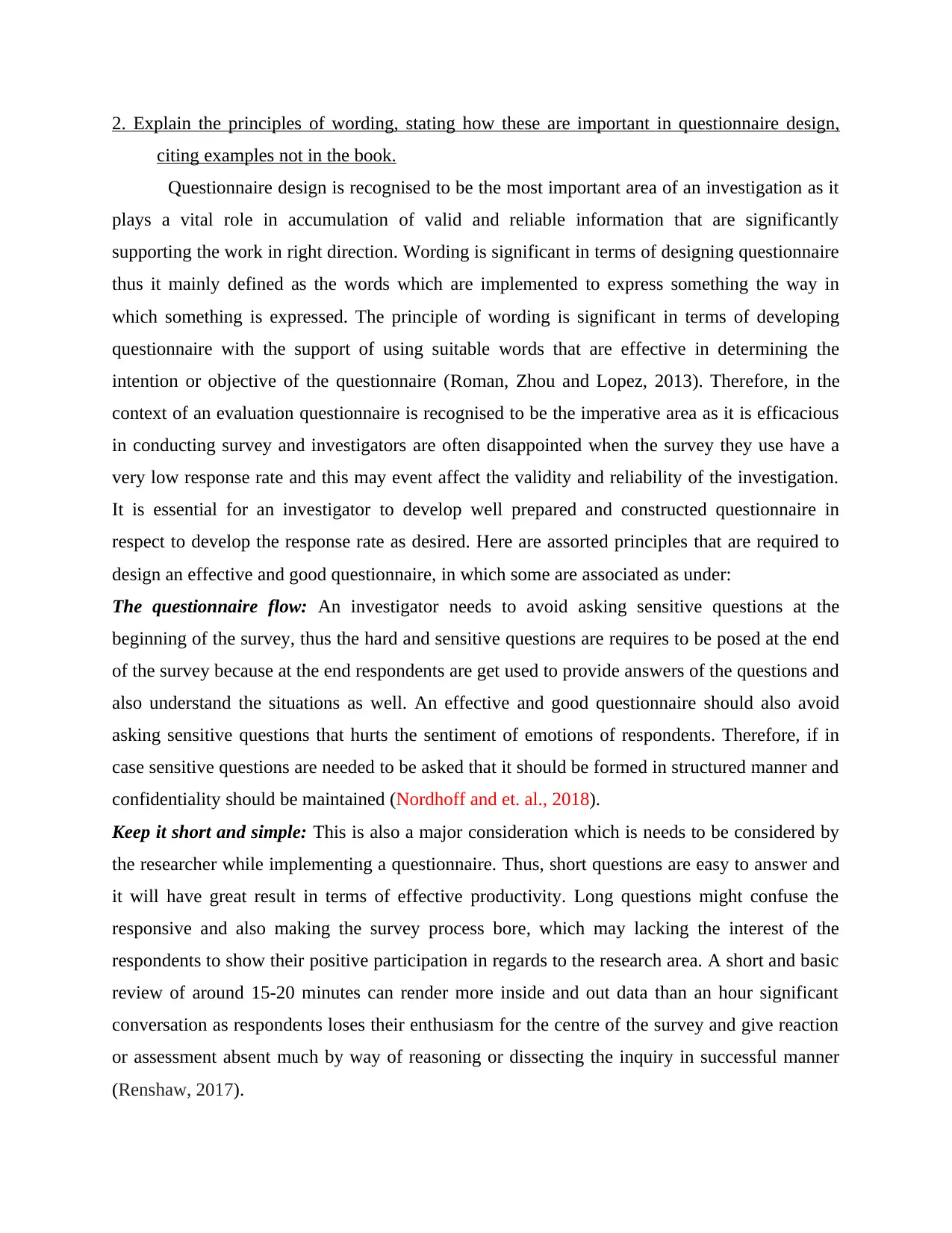
2. Explain the principles of wording, stating how these are important in questionnaire design,
citing examples not in the book.
Questionnaire design is recognised to be the most important area of an investigation as it
plays a vital role in accumulation of valid and reliable information that are significantly
supporting the work in right direction. Wording is significant in terms of designing questionnaire
thus it mainly defined as the words which are implemented to express something the way in
which something is expressed. The principle of wording is significant in terms of developing
questionnaire with the support of using suitable words that are effective in determining the
intention or objective of the questionnaire (Roman, Zhou and Lopez, 2013). Therefore, in the
context of an evaluation questionnaire is recognised to be the imperative area as it is efficacious
in conducting survey and investigators are often disappointed when the survey they use have a
very low response rate and this may event affect the validity and reliability of the investigation.
It is essential for an investigator to develop well prepared and constructed questionnaire in
respect to develop the response rate as desired. Here are assorted principles that are required to
design an effective and good questionnaire, in which some are associated as under:
The questionnaire flow: An investigator needs to avoid asking sensitive questions at the
beginning of the survey, thus the hard and sensitive questions are requires to be posed at the end
of the survey because at the end respondents are get used to provide answers of the questions and
also understand the situations as well. An effective and good questionnaire should also avoid
asking sensitive questions that hurts the sentiment of emotions of respondents. Therefore, if in
case sensitive questions are needed to be asked that it should be formed in structured manner and
confidentiality should be maintained (Nordhoff and et. al., 2018).
Keep it short and simple: This is also a major consideration which is needs to be considered by
the researcher while implementing a questionnaire. Thus, short questions are easy to answer and
it will have great result in terms of effective productivity. Long questions might confuse the
responsive and also making the survey process bore, which may lacking the interest of the
respondents to show their positive participation in regards to the research area. A short and basic
review of around 15-20 minutes can render more inside and out data than an hour significant
conversation as respondents loses their enthusiasm for the centre of the survey and give reaction
or assessment absent much by way of reasoning or dissecting the inquiry in successful manner
(Renshaw, 2017).
citing examples not in the book.
Questionnaire design is recognised to be the most important area of an investigation as it
plays a vital role in accumulation of valid and reliable information that are significantly
supporting the work in right direction. Wording is significant in terms of designing questionnaire
thus it mainly defined as the words which are implemented to express something the way in
which something is expressed. The principle of wording is significant in terms of developing
questionnaire with the support of using suitable words that are effective in determining the
intention or objective of the questionnaire (Roman, Zhou and Lopez, 2013). Therefore, in the
context of an evaluation questionnaire is recognised to be the imperative area as it is efficacious
in conducting survey and investigators are often disappointed when the survey they use have a
very low response rate and this may event affect the validity and reliability of the investigation.
It is essential for an investigator to develop well prepared and constructed questionnaire in
respect to develop the response rate as desired. Here are assorted principles that are required to
design an effective and good questionnaire, in which some are associated as under:
The questionnaire flow: An investigator needs to avoid asking sensitive questions at the
beginning of the survey, thus the hard and sensitive questions are requires to be posed at the end
of the survey because at the end respondents are get used to provide answers of the questions and
also understand the situations as well. An effective and good questionnaire should also avoid
asking sensitive questions that hurts the sentiment of emotions of respondents. Therefore, if in
case sensitive questions are needed to be asked that it should be formed in structured manner and
confidentiality should be maintained (Nordhoff and et. al., 2018).
Keep it short and simple: This is also a major consideration which is needs to be considered by
the researcher while implementing a questionnaire. Thus, short questions are easy to answer and
it will have great result in terms of effective productivity. Long questions might confuse the
responsive and also making the survey process bore, which may lacking the interest of the
respondents to show their positive participation in regards to the research area. A short and basic
review of around 15-20 minutes can render more inside and out data than an hour significant
conversation as respondents loses their enthusiasm for the centre of the survey and give reaction
or assessment absent much by way of reasoning or dissecting the inquiry in successful manner
(Renshaw, 2017).
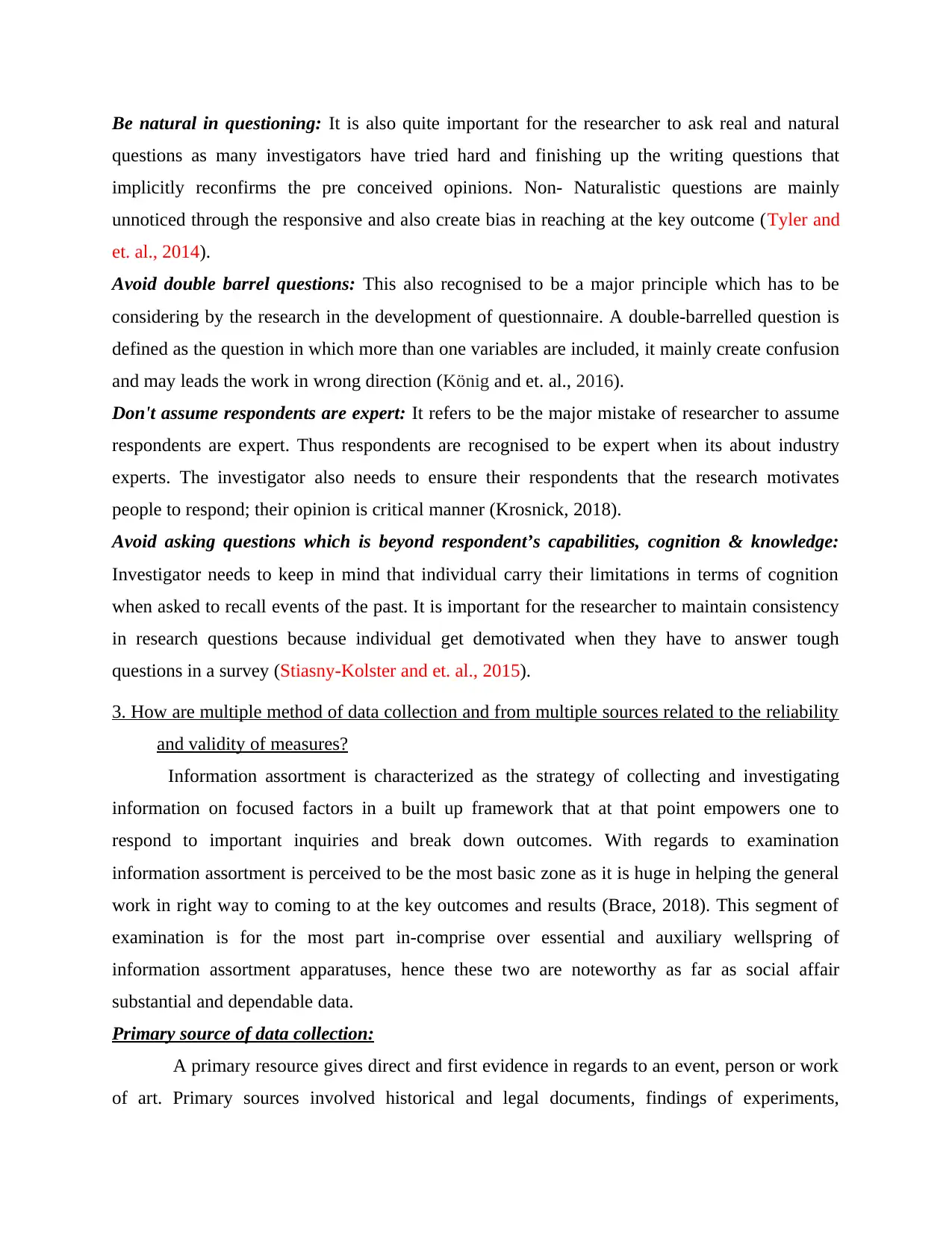
Be natural in questioning: It is also quite important for the researcher to ask real and natural
questions as many investigators have tried hard and finishing up the writing questions that
implicitly reconfirms the pre conceived opinions. Non- Naturalistic questions are mainly
unnoticed through the responsive and also create bias in reaching at the key outcome (Tyler and
et. al., 2014).
Avoid double barrel questions: This also recognised to be a major principle which has to be
considering by the research in the development of questionnaire. A double-barrelled question is
defined as the question in which more than one variables are included, it mainly create confusion
and may leads the work in wrong direction (König and et. al., 2016).
Don't assume respondents are expert: It refers to be the major mistake of researcher to assume
respondents are expert. Thus respondents are recognised to be expert when its about industry
experts. The investigator also needs to ensure their respondents that the research motivates
people to respond; their opinion is critical manner (Krosnick, 2018).
Avoid asking questions which is beyond respondent’s capabilities, cognition & knowledge:
Investigator needs to keep in mind that individual carry their limitations in terms of cognition
when asked to recall events of the past. It is important for the researcher to maintain consistency
in research questions because individual get demotivated when they have to answer tough
questions in a survey (Stiasny-Kolster and et. al., 2015).
3. How are multiple method of data collection and from multiple sources related to the reliability
and validity of measures?
Information assortment is characterized as the strategy of collecting and investigating
information on focused factors in a built up framework that at that point empowers one to
respond to important inquiries and break down outcomes. With regards to examination
information assortment is perceived to be the most basic zone as it is huge in helping the general
work in right way to coming to at the key outcomes and results (Brace, 2018). This segment of
examination is for the most part in-comprise over essential and auxiliary wellspring of
information assortment apparatuses, hence these two are noteworthy as far as social affair
substantial and dependable data.
Primary source of data collection:
A primary resource gives direct and first evidence in regards to an event, person or work
of art. Primary sources involved historical and legal documents, findings of experiments,
questions as many investigators have tried hard and finishing up the writing questions that
implicitly reconfirms the pre conceived opinions. Non- Naturalistic questions are mainly
unnoticed through the responsive and also create bias in reaching at the key outcome (Tyler and
et. al., 2014).
Avoid double barrel questions: This also recognised to be a major principle which has to be
considering by the research in the development of questionnaire. A double-barrelled question is
defined as the question in which more than one variables are included, it mainly create confusion
and may leads the work in wrong direction (König and et. al., 2016).
Don't assume respondents are expert: It refers to be the major mistake of researcher to assume
respondents are expert. Thus respondents are recognised to be expert when its about industry
experts. The investigator also needs to ensure their respondents that the research motivates
people to respond; their opinion is critical manner (Krosnick, 2018).
Avoid asking questions which is beyond respondent’s capabilities, cognition & knowledge:
Investigator needs to keep in mind that individual carry their limitations in terms of cognition
when asked to recall events of the past. It is important for the researcher to maintain consistency
in research questions because individual get demotivated when they have to answer tough
questions in a survey (Stiasny-Kolster and et. al., 2015).
3. How are multiple method of data collection and from multiple sources related to the reliability
and validity of measures?
Information assortment is characterized as the strategy of collecting and investigating
information on focused factors in a built up framework that at that point empowers one to
respond to important inquiries and break down outcomes. With regards to examination
information assortment is perceived to be the most basic zone as it is huge in helping the general
work in right way to coming to at the key outcomes and results (Brace, 2018). This segment of
examination is for the most part in-comprise over essential and auxiliary wellspring of
information assortment apparatuses, hence these two are noteworthy as far as social affair
substantial and dependable data.
Primary source of data collection:
A primary resource gives direct and first evidence in regards to an event, person or work
of art. Primary sources involved historical and legal documents, findings of experiments,
⊘ This is a preview!⊘
Do you want full access?
Subscribe today to unlock all pages.

Trusted by 1+ million students worldwide
1 out of 20
Related Documents
Your All-in-One AI-Powered Toolkit for Academic Success.
+13062052269
info@desklib.com
Available 24*7 on WhatsApp / Email
![[object Object]](/_next/static/media/star-bottom.7253800d.svg)
Unlock your academic potential
Copyright © 2020–2025 A2Z Services. All Rights Reserved. Developed and managed by ZUCOL.





